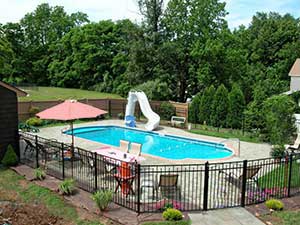Modern pools are likely up to code, but older pools may not be safe. Pools even as  young as 10 years old may have violations on safety and energy usage codes.
young as 10 years old may have violations on safety and energy usage codes.
What are Swimming Pool Codes?
The “Swimming Pool Code” of 1968 set standards for electrical equipment used around pools, including those that circulate the water. Heaters were given special provisions that include proper location that prevents carbon monoxide buildup, ventilation and a safety shut-off switch.
Other things to look for include proper bonding and grounding, which prevent stray voltage from causing electrical shocks, and drainage entrapment violations.
Even diving boards come under code restrictions. For instance, a “diving pool” must be at least 8’ deep under the board, and minimums for board length, width and head room exist as well. Certain heights are required to have guard rails.
Safety Barriers Prevent Drowning Deaths
The U.S. Consumer Product Safety Commission issued a Safety Guidelines report stating that each year thousands of American families suffer swimming pool tragedies, the majority of which involve drownings and non-fatal drownings of young children ages 1 to 3. It is the leading cause of unintentional death for 1- to 4-year-old children. Pools as small as portable or “kiddie” pools can be a danger.
One of the best ways to prevent drownings in residential pools is to construct and maintain barriers that prohibit access to pools, spas and hot tubs. Barriers can include fencing, walls, gates, door alarms and power safety covers. Even your home pool is required by code to be fenced in with a self-closing, self-latching gate.
Call Först if you Have Concerns
For the protection of your loved ones, Först Consulting Group urges you to ensure that your pool is safe—and up to code. If you have questions or need us to perform a pool inspection, please contact Först for an appointment.




